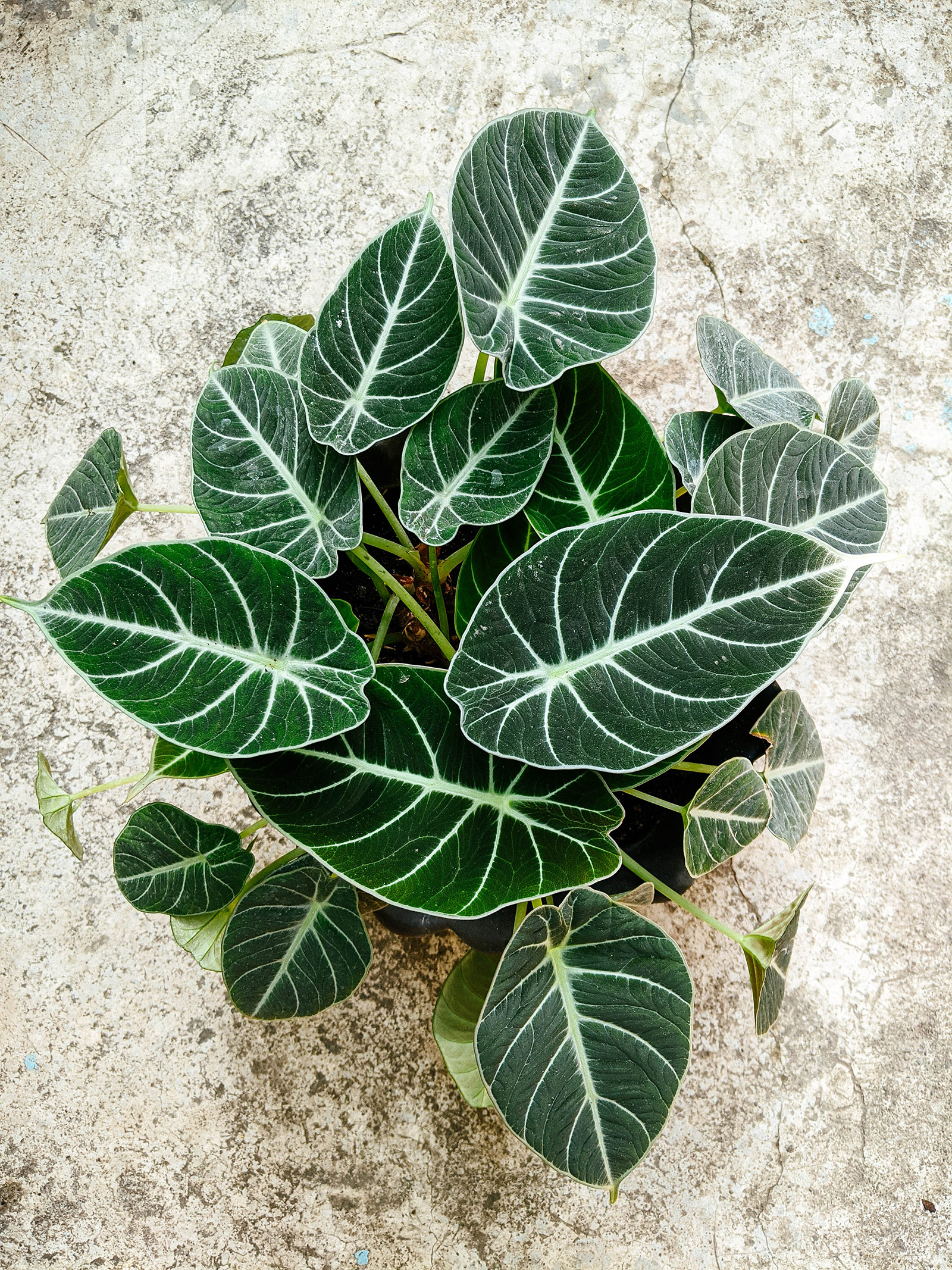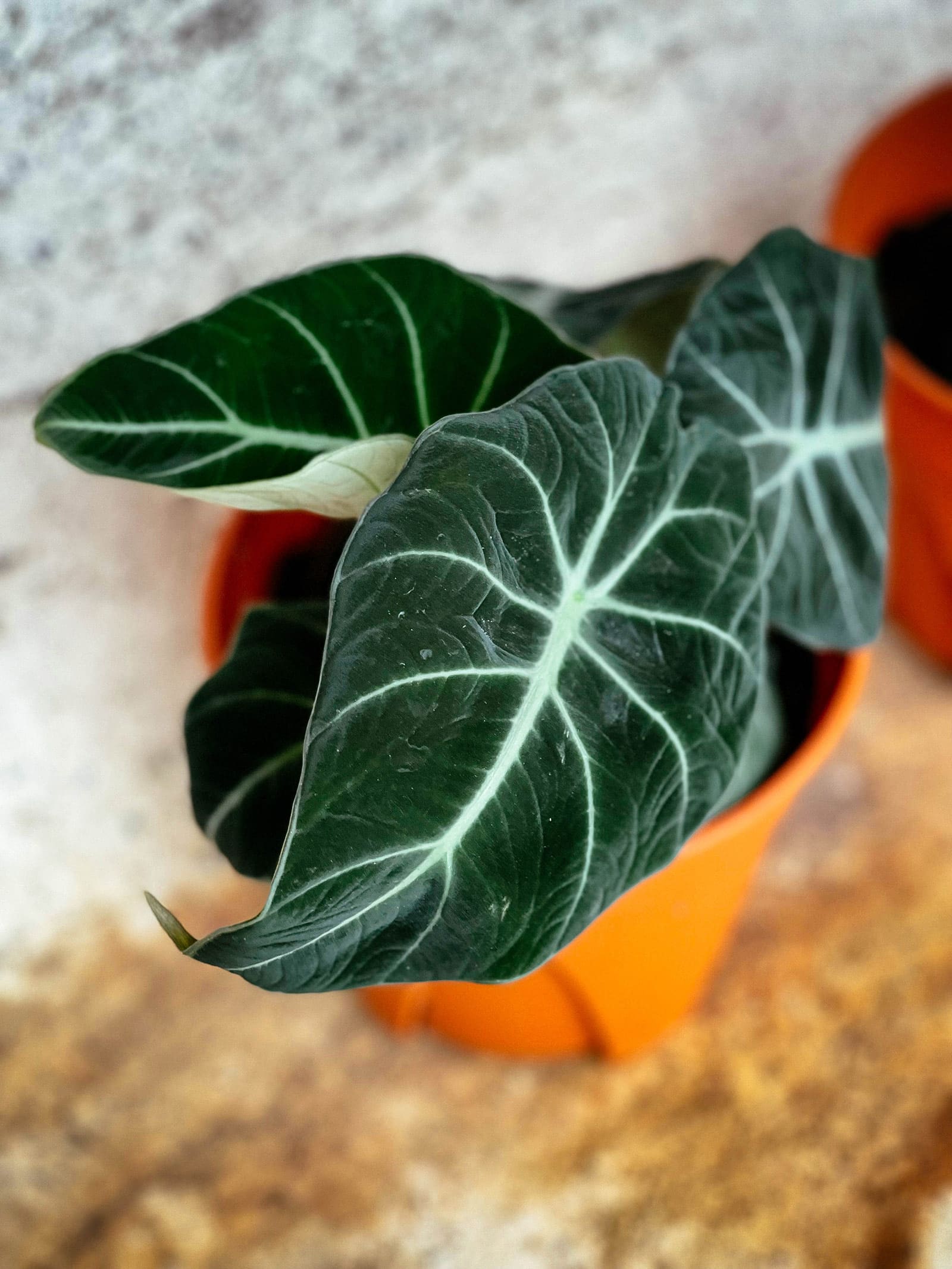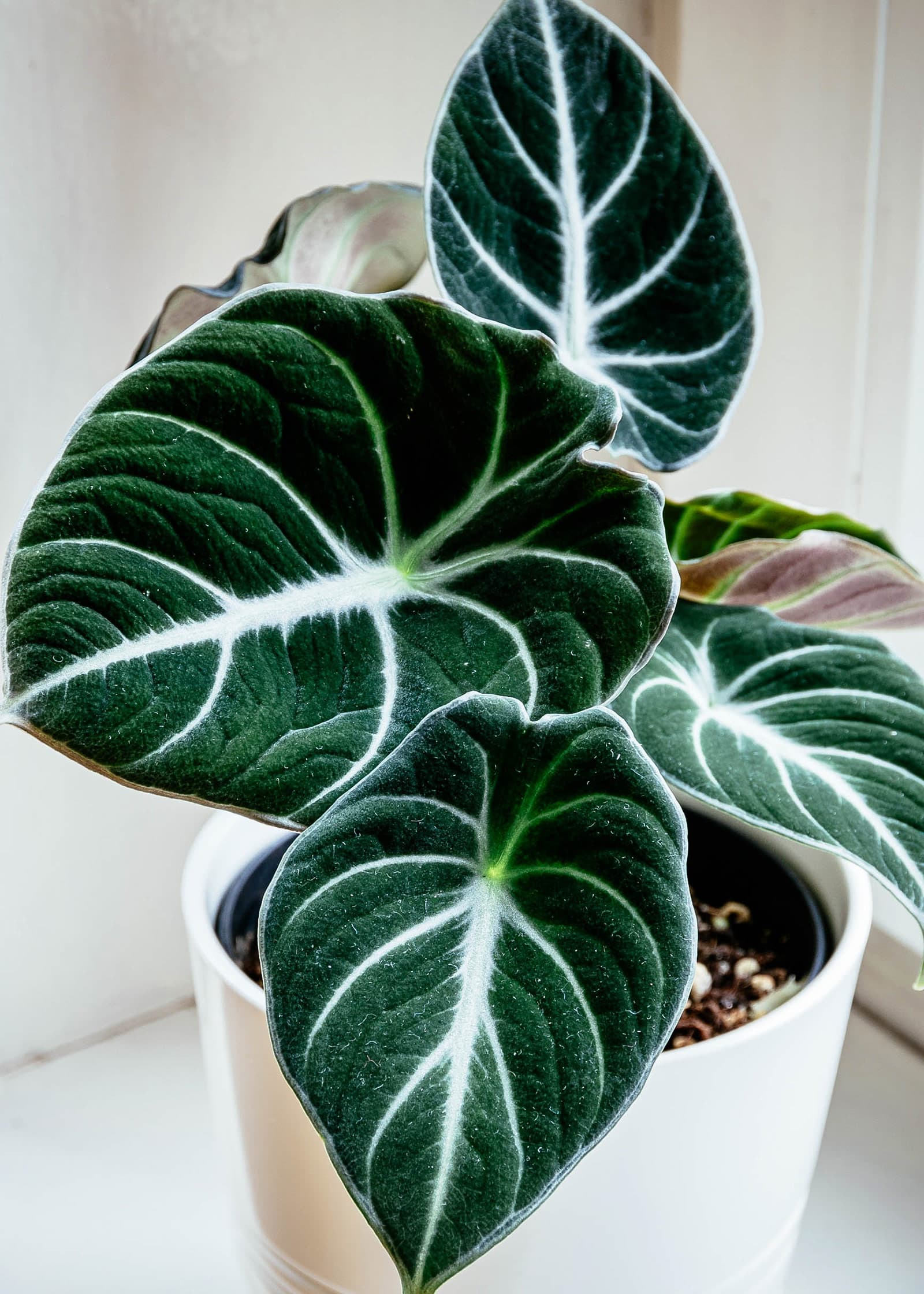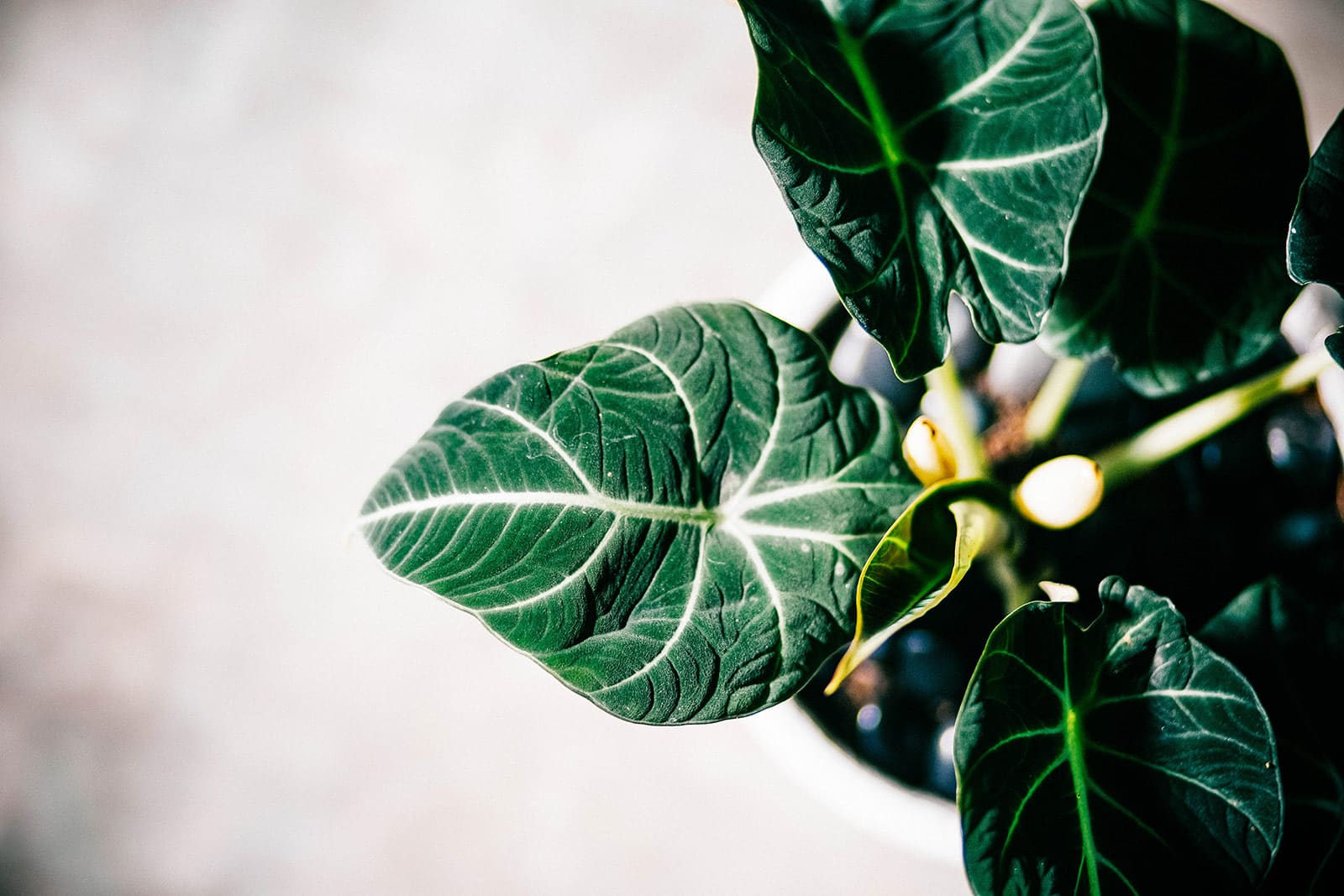Looking to add one of the many beautiful Alocasia houseplant species to your collection, but not sure if you’re ready for the huge size that some of these tropicals can reach?
Let me introduce you to Alocasia reginula, common name Alocasia ‘Black Velvet’. It has all the beauty of an Alocasia, but in a tiny package!
Keep reading for everything you need to know about Alocasia ‘Black Velvet’ care and growing this coveted aroid indoors.
| Common name(s) | Alocasia ‘Black Velvet’, black velvet Alocasia |
| Scientific name | Alocasia reginula |
| Family | Araceae |
| Height and spread | Up to 1.6 feet high and 1 feet wide |
| Light | Bright indirect |
| Soil type | Moisture-retaining but well-draining |
| Water | Let top of soil dry out |
Disclosure: If you shop from my article or make a purchase through one of my links, I may receive commissions on some of the products I recommend.

About Alocasia ‘Black Velvet’
Description
Scientifically known as Alocasia reginula, this popular houseplant is usually referred to as Alocasia ‘Black Velvet’. A pretty appropriate name given its dark green to black, velvety foliage, but not entirely accurate: The way it’s written suggests that this is a selectively bred cultivar, but it’s actually not. It’s a proper species that occurs in the wild.
This confusion likely stems from the fact that the plant was available commercially before it was actually described scientifically. Nurseries literally didn’t have a name to go off, so they just made one up!
Alocasia ‘Black Velvet’ has recently gained massive popularity in the houseplant hobby, much like another Alocasia stunner, ‘Polly’.
In fact, the same goes for many of the other small members of the genus, including Alocasia ‘Dragon Scale’, Alocasia cuprea, and Alocasia zebrina.
As a whole, these plants are often referred to as the jewel Alocasias, since they’re all small in size but sport spectacularly colorful and textured foliage.
Alocasia ‘Black Velvet’ can be told apart from its other jewel Alocasia cousins by its oval, slightly fuzzy leaves. The foliage is a deep green to almost blackish when viewed from the front, with striking silvery-green leaf veins. The backs of the leaves are a lighter reddish green.
Alocasia ‘Black Velvet’ is unlikely to flower indoors, but on the off chance yours does, the flower is rather unassuming: a simple white spadix encased by a pale yellow spathe. This is similar to other aroids (such as Pothos, Philodendrons, and Chinese evergreens), which are grown for their foliage rather than their flowers.
The species grows to a maximum size of only around 1.6 feet, making it much smaller than some of its humongous cousins, like the giant Taro (Alocasia macrorrhizos).
Natural habitat
As I mentioned earlier, Alocasia ‘Black Velvet’ was offered for sale commercially before it was scientifically described. This presented a bit of an issue in terms of figuring out its natural habitat: Botanists knew they were dealing with a new, undescribed species, but they didn’t know exactly where it was from.
The 1998 publication in the Singapore Gardens’ Bulletin, which first described the species based on specimens found for sale in the US, listed its distribution as “?Borneo” and its habitat as “Unknown.”
In 2021, a study was published which explains that Alocasia reginula has since been discovered to be endemic to the Tabin Wildlife Reserve, on the Malaysian side of the island of Borneo (in the state of Sabah). Here, it’s noted to grow on “heavily shaded karst [limestone] cliffs”.

Alocasia ‘Black Velvet’ varieties
Cultivars
Although you probably won’t find them for sale in any old plant store and their prices will scare away any but the most dedicated Alocasia aficionados, there are actually a few cultivars of Alocasia ‘Black Velvet’/reginula out there.
Two of the most common cultivars are:
- Alocasia ‘Silver Velvet’: The name says it all. The same velvety leaves, but greyish in color.
- Alocasia ‘Black Ninja’: Similar in appearance to ‘Black Velvet’, especially when it matures, but with glossier and thicker foliage.
I’ve also seen other plants with ‘Ninja’ in their name, but it’s not entirely clear to me if these are all actually different. Since these cultivars are relatively new, after all, they’re not established yet and may go by different names. Examples of names I’ve seen are ‘Monster Ninja’, ‘Mythic™ Ninja’ and even just ‘Ninja’.
Hybrids
There are at least two relatively common hybrids out there that have Alocasia ‘Black Velvet’ in their parentage. One was produced in 2007 by crossing ‘Black Velvet’ with the massive Alocasia odora. This resulted in a plant patented as Alocasia ‘Regal Shields’ (or sometimes as Alocasia x reginora), which looks pretty much exactly how you’d expect. It has odora’s size and smooth leaves, but reginula’s beautiful dark color and lighter leaf veins.
Another reasonably common hybrid is Alocasia ‘Black Velvet’ x Alocasia melo, the result of which carries the name of Alocasia ‘Maharani’ or sometimes ‘Grey Dragon’. This really is a very nice little jewel Alocasia. The textured leaves are almost grey (gray) in color.
Aroid enthusiasts are always experimenting with crossing different Alocasias, so we’re sure to see more Alocasia ‘Black Velvet’ hybrids popping up in the future.
Where to buy Alocasia ‘Black Velvet’ plants:

Caring for Alocasia ‘Black Velvet’
Light and temperature
Like most jungle plants, Alocasia ‘Black Velvet’ loves light, but it’s not a big fan of receiving large amounts of direct sun. After all, in the species’ natural habitat, taller trees would block out the harshest light!
You can place yours on a windowsill, but try to avoid spots where its leaves might burn. You can also go for artificial lighting, which Alocasias are known to grow well under.
Temperature-wise, you’ll have to keep these plants warm. Room temperature works well, so if you’re comfortable, then the same goes for your Alocasia. Warmer isn’t a problem either, but cold is not tolerated at all and will trigger dormancy, which I’ll discuss more in-depth below. In any case, try not to let temps drop below 55°F.
Be sure to also keep your Alocasia ‘Black Velvet’ away from A/C units, heaters and the like. The plant’s a bit fussy about its environment and doesn’t respond well to drastic changes in temperature.
Water and humidity
Jewel Alocasias like ‘Black Velvet’ aren’t known for being the easiest houseplant to grow, and much of that has to do with their watering needs. With this species in particular, rot is always a danger. It loves water, but it’s easy to overdo it and end up with a pile of mush!
Remember, this Alocasia naturally grows on limestone, which drains quickly. This has forced the plants to adapt to making do with a little less. That’s also why their leaves are thicker and more leathery than those of many of their cousins that hail from wetter regions: it helps them store water more efficiently.
So what does all this mean for you if you’d like to grow an Alocasia ‘Black Velvet’?
Well, first off, be sure to also take a look at the section on soil below. If you don’t have that part down, even the best watering habits won’t help.
If you’re using a suitable, well-draining Alocasia soil, you can water whenever the top of the soil (up to halfway down) has gone dry. This point will usually take significantly longer to reach in winter than during the warm and light summer months, when your plant is hopefully growing and using plenty of water.
If you’re not sure whether it’s time yet, stick a finger into the soil to gauge the moisture level.
Tip: I’ve seen one indoor gardener recommend companion planting jewel Alocasias like this one with small ferns, like those from the genus Nephrolepis. This seems like it may be worth a shot. The fern can help take up excess water, giving you a bit more wiggle room in terms of moisture levels.
You should also keep humidity in mind. These guys despise dry air, which makes them a magnet for spider mites and other problems! It’s best to keep them at 65 percent or above at all times, which may mean that you need to consider something like a humidity cabinet if your home is on the dry side. A humidifier can also help.
Soil and planting
Okay, so what’s all this fuss about the right soil for Alocasia ‘Black Velvet’? Well, the basic gist of it is that this plant does like plenty of moisture, but standing water can cause root rot. This common houseplant ailment is often a death sentence.
To make sure your Alocasia won’t rot—but doesn’t go thirsty either—you’ll need to mix a soil that retains some water, but allows the excess to drain freely. Luckily, this is not too difficult to do. The resulting mixture is suitable for a wide range of houseplants, especially fellow members of the Aroid family.
This is the basic recipe I use for plants like Alocasia ‘Black Velvet’:
- 2 parts high-quality houseplant soil
- 1 part sphagnum moss
- 1 part perlite
- 1 part fine orchid bark
With this recipe, the soil and moss will help to retain the right amount of water, while gritty perlite and orchid bark let the rest drain and prevent your plant from drowning.
As for a planter for Alocasia ‘Black Velvet’, like with most houseplants, it doesn’t really matter what you go for. The important thing is just to make sure it has a drainage hole, or drill one yourself.
Recommended products for Alocasia ‘Black Velvet’ plant care:
- FoxFarm Ocean Forest Potting Soil
- Perfect Plants Organic Perlite
- Better-Gro Orchid Bark
- Better-Gro Orchid Moss
Alocasia hibernation
Did you let the temperatures in your home drop too much? Don’t be surprised if you find your Alocasia suddenly shedding its leaves and appearing to die. (This happens more often than you think, especially in the winter months when people tend to be traveling for long stretches over the holidays.)
These plants don’t like the cold and can go into dormancy if things get too chilly. They absorb all the nutrients from their leaves, store them in their bulbs and hang out in a leafless state until things start to warm back up. This is not problematic, but it’s not exactly the prettiest thing to look at either!
Here’s what you can do:
- Leave the corms in the planter, placing them in a cool and dark spot to wait for spring. You can water very occasionally.
- When the moment has come, place the planter with the corms in a warm and light spot in your home. Water deeply.
- Wait for the first leaves to sprout and then resume a regular watering schedule.
Fertilizing
Alocasia ‘Black Velvet’ is not a quick grower, so it doesn’t need a lot of fertilizer. Still, it will benefit from a little plant food during the spring and summer growing season. You can use a diluted liquid houseplant fertilizer around once a month if your Alocasia is doing well.
Don’t use fertilizer on plants that are unhappy or aren’t growing, especially during winter and especially if they’re dormant. You’ll just damage the roots.
Recommended fertilizers for Alocasia ‘Black Velvet’:
- Maxsea All-Purpose Seaweed Plant Food
- Houseplant Resource Center Liquid Fertilizer for Houseplants
- Instant Biologics Instant Plant Food (Fizzing Nutrient Tablets)
Pruning
You won’t have to prune your Alocasia ‘Black Velvet’ much at all, except to remove the occasional dead leaf. Alocasias tend to let their bottom leaves die off as new ones sprout.
Dividing or repotting
You can repot your Alocasia ‘Black Velvet’ every two to three years or whenever the plant outgrows its current planter (which can take a good while given its small size and slow growth rate).
However, if it happens to have produced offshoots, you can also opt to divide! This way you get an extra plant and can keep the original in its current planter. I’ll go over how to do this in the next section.

Propagating Alocasia ‘Black Velvet’
One downside of Alocasias is that they’re not as easy to propagate as many other houseplants. Because the members of this genus sprout leaves from a central corm, they don’t have stems, which means that quick and simple stem cuttings are not an option.
You can still multiply your Alocasia ‘Black Velvet’, but only if it has produced offshoots and/or extra bulbs. This is best done if you were going to repot anyway, since you’ll have to remove the plant from its pot.
Here’s how you do it:
- Take your Alocasia out of its planter and lay out the contents on some newspaper or trash bags. With some luck, the different shoots will come loose by themselves.
- If the shoots are firmly attached, you can cut through the root ball using a sharp and clean knife.
- Check the soil for any extra corms. You can use these to grow more Alocasias.
- Pot up both the mother plant and the offshoot(s) you removed using fresh Alocasia soil.
Did you know? Alocasia ‘Black Velvet’ is known for commonly being micropropagated commercially by means of tissue culture. This is a technique that we can’t really use in our homes since it’s a little too complicated, but it allows growers to easily mass-produce the plant.

Is Alocasia ‘Black Velvet’ toxic to cats and dogs?
Like other members of the genus Araceae (the aroids), all parts of Alocasia ‘Black Velvet’ contain calcium oxalate crystals. These microscopic crystals are not toxic, but they can produce irritation and swelling, so it’s best to keep this plant out of reach of pets and children.
Sources:
https://powo.science.kew.org/taxon/1006568-1
https://patents.google.com/patent/USPP27050P2/
https://aroidiaresearch.org/areginor.htm
https://www.aroidpedia.com/journal/category/Cultivar
Hay A (1998) Alocasia (Araceae-Colocasieae) in West Malesia & Sulawesi. Gardens’ Bulletin Singapore 50: 221–334.
Wong, S. Y., & Joling, J. (2021). Checklist of aroids (Alismatales, Araceae) from Sabah (Malaysian Borneo). Check List, 17, 931.
















Great information! Thanks for sharing.